Dec 07, 2009
The CIA’s ‘global cooling’ files
By Maurizio Morabito, The UK Spectator, 5 December 2009
Sparked by an older ICECAP story on the CIA files on the Ice Age consensus of scientists in 1974, Maurizio unearthed the CIA files and blogged on it here.
The threat of a new ice age loomed so large in 1974 that American intelligence collated a report on the likely effects. Maurizio Morabito unearthed it.
A high-priority government report warns of climate change that will lead to floods and starvation. ‘Leading climatologists’ speak of a ‘detrimental global climatic change’, threatening ‘the stability of most nations’. The scenario is eerily familiar although the document - never made public before - dates from 1974. But here’s the difference: it was written to respond to the threat of global cooling, not warming. And yes, it even mentions a ‘consensus’ among scientists.
‘A Study of Climatological Research as it Pertains to Intelligence Problems’, written by the CIA for ‘internal planning purposes’ in August 1974, goes a little way towards explaining why some people over a certain age experience a sense of deja-vu when climate change is mentioned; in the mid-1970s there really was a lot of scientific discussion about global cooling. With the benefit of hindsight, reading it makes one feel wry and embarrassed. So many of the terms bandied about 35 years ago are still being employed by today’s fear-mongers, about the very opposite phenomenon.
It is as if climate scares had to follow a set pattern. Back in 1974 the usual disasters were projected: the ‘new climatic era’ was said to be bringing famine, starvation, refugee crises, floods, droughts, crop and monsoon failures, and all sorts of extreme weather phenomena. The Sahara would expand. World grain reserves, already at less than a month’s supply, would be depleted. A list of past civilisations brought down by ‘major and minor’ cooling episodes was given, which included the Indus, Hittites, Mycenaean, and the Mali empire of Africa. Any possible benefits to climate change were barely mentioned.
More parallels can be drawn. According to the CIA report, in 1974 climate science was developing ‘a successful climatic prediction model’, as indeed it still is. Government intervention had brought together eminent scientists who had previously been at odds with each other then had established a ‘scientific consensus’ on ‘global climate change’. The scientists claimed this pattern of cooling would cause ‘major economic problems around the world’. Dealing with this would, of course, require the creation of several new government agencies. The media at the time seized on all of this, just as it is doing now. Newsweek and the New York Times described the global cooling threat.
How is it that the parallels between that 1970s panic and today’s have been so little remarked upon? And it doesn’t stop there. There have even been recent attempts to label the ‘global cooling consensus’ a ‘myth’, most notably in a well-publicised article by Thomas C. Peterson, William M. Connolley, and John Fleck published by the American Meteorological Society in September 2008.
It’s easy to miss what you do not look for. Mentions of a global cooling consensus appear as far back as 1961. I found the CIA report referred to in a 1976 newspaper article and was doubly amazed to discover it was available as a microfiche in the British Library.
So what would have prompted the CIA to compile such a dossier? The most likely explanation is what it describes as the loss of ‘a significant portion’ of the USSR’s winter wheat crop in 1972. The harvest was so poor that the CIA saw geopolitical ramifications. Its report says that ‘the politics of food’ is a complex business, which cannot be understood by ‘existing analytical tools’. So to address a political problem, they asked scientists to come up with a solution. Precisely the same thing is happening today. One might almost conclude that, in the world of climatology, theories are made to order.
Or is the problem with the general public, who cannot talk about climate except in doom-laden terms, and for whom the sky is the last animist god? This might be the most important lesson of the 1974 report on global cooling: that we need to grow up, separate climatology from fear, and recognise - much as it pains politicians and scientists - that our understanding of how climate changes remains in its infancy.
See Maurizio’s post here.
ICECAP Note Tom Peterson is NOAA NCDC chief alarmist under Tom Karl. Tom engineered the removal of the UHI adjustment in USHCNv2 in 2007. William Connelly is part of the Real Climate propaganda team and is the prime filter on the climate content of Wikipedia, keeping non AGW information out. Both are key players in the fraud that the emails provided a window into.
Dec 06, 2009
From Russia with Love (Spasiba!)
By Will Stewart and Martin Delgado, Daily Mail Online
Suspicions were growing last night that Russian security services were behind the leaking of the notorious British ‘Climategate’ emails which threaten to undermine tomorrow’s Copenhagen global warming summit.
An investigation by The Mail on Sunday has discovered that the explosive hacked emails from the University of East Anglia were leaked via a small web server in the formerly closed city of Tomsk in Siberia. The leaks scandal has left the scientific community in disarray after claims that key climate change data was manipulated in the run-up to the climate change summit of world leaders.
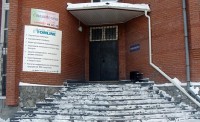
The row erupted when hundreds of messages between scientists at the university’s Climatic Research Unit (CRU) and their colleagues around the world were placed on the internet along with other documents. The CRU is internationally recognised as one of the most important sources of information on the rise in global temperatures. Its data is relied on by the Intergovernmental Panel on Climate Change, the UN body which co-ordinates the world response to climate change.
But now the CRU’s findings are under suspicion. The leaked emails appear to show that CRU director Professor Phil Jones and colleagues attempted to manipulate the figures and hide their raw data from researchers with opposing views. Prof Jones has stepped aside from his post while claims are investigated that he wanted certain papers excluded from the United Nations’ next major assessment of climate science. Russia - one of the world’s largest producers and users of oil and gas - has a vested interest in opposing sweeping new agreements to cut emissions, which will be discussed by world leaders in Copenhagen tomorrow.
Russia believes current rules are stacked against it, and has threatened to pull the plug on Copenhagen without concessions to Kremlin concerns. The Mail on Sunday understands that the hundreds of hacked emails were released to the world via a tiny internet server in a red brick building in a snow-clad street in Tomsk. The original internet link was quickly removed after the information spread from it like wildfire on to international websites.
A message written in English accompanied the leaked package of emails. It read: “We feel that climate science is too important to be kept under wraps. We hereby release a random selection of correspondence, code and documents. Hopefully it will give some insight into the science and the people behind it.”
Climate-change sceptics in the West seized on the emails as evidence that the books were being cooked by the global-warming lobby. Stories highlighting the ‘scandal’ began to appear from November 21, three or four days after the information was first released on to the server. Some of the leaked emails date back to March, 1996. Tomcity - the server - and Tomline, its parent company, were unavailable for comment yesterday. The firm offers an internet security business to prevent hacking and bugs and the ‘compromising of confidential information’.
Other divisions of the firm are involved in laying the cable which provides high-speed internet access to companies in the Siberian city. The server is believed to be used mainly by Tomsk State University, one of the leading academic institutions in Russia, and other scientific institutes. Computer hackers in Tomsk have been used in the past by the Russian secret service (FSB) to shut websites which promote views disliked by Moscow. Such arrangements provide the Russian government with plausible deniability while using so-called ‘hacker patriots’ to shut down websites.
In 2002, Tomsk students were said to have launched a ‘denial of service’ attack at the Kavkaz-Tsentr portal, a site whose reports about Chechnya angered Russian officials. The FSB office in Tomsk put out a special Press release saying that what the students had done was a legitimate ‘expression of their position as citizens, one worthy of respect’. A Russian hacking specialist said last night ‘There is no hard evidence that the hacking was done from Tomsk, though it might have been. ‘There has been speculation the hackers were Russian. It appears to have been a sophisticated and well-run operation, that had a political motive given the timing in relation to Copenhagen.’
And gazeta.ru news website, having received information about the Tomsk server connection, said: ‘Presumably it was Russian hackers who broke into the servers of the university.’ The university said that there was strict security on its server, heightening the theory that an extremely sophisticated hacking operation was carried out to obtain it. East Anglia University has gone out of its way to promote itself to students from the former Soviet Union. Its website says that 33 Russian students currently study there. It is not known if they have fallen under suspicion as part of the police investigation.
Tomsk - 2,190 miles east of Moscow - was closed to foreigners during the Soviet era. Its population of 630,000 includes the secret satellite city of Seversk, formerly known as Tomsk-7 and seven miles to the north, which houses strategic uranium and plutonium plants and remains shut to Westerners. It was built in the Fifties by 20,000 prisoners from nearby Siberian labour camps.
Today, the city, and especially Seversk, remains closely monitored by the FSB, the successor security service to the Soviet-era KGB. The city’s academic quarter - some of which uses the server that revealed the climate-change scandal - includes a leading world expert on the subject, Professor Sergei Kirpotin, a botanist of Tomsk University. He was unavailable yesterday and has not commented on the email controversy. Previously, in research with academic Judith Marquand from Oxford University, he warned of the risk of the release of billions of tons of methane gas because of the melting of the Siberian peat bogs, seen as being due to global warming. Kirpotin described the situation as ‘an ecological landslide that is probably irreversible and is undoubtedly connected to climatic warming’.
Russia is the world’s third-largest emitter of greenhouse gases, and lags behind many Western countries in greening its industry. However, its emissions plunged in the Nineties as its economy collapsed and it now sits on a treasure trove of unused carbon emission permits that could be sold to other countries.
These are due to expire in 2012 with the Kyoto Treaty. The Kremlin wants these to be rolled forward and last week signalled they would not sign a new deal without this, threatening the whole Copenhagen summit. The crisis caused by the Climategate email row has resulted in the UK’s Met Office being forced to re-examine 160 years’ of climate data after admitting that public confidence in the science on man-made warming had been undermined by the leaks.
A new three-year analysis of the data will mean the Met Office - which works closely with Prof Jones’s unit - will not be able to declare with complete confidence the extent of global warming trends until the end of 2012.
The Norwich-based university has called in Sir Muir Russell, a former senior civil servant, to investigate the row, which is also the subject of a separate probe by the Information Commissioner’s Office. Last night, news of the Kremlin connection coincided with Norfolk Police confirming to The Mail on Sunday that it was now ‘investigating criminal offences’ in relation to the data breach.
The Mail on Sunday tracked down Professor Ross McKitrick, a world-renowned expert on the economic effects of climate change, who said Prof Jones had tried to stop his findings being published in an influential UN report. Prof McKitrick concluded that Jones and his colleagues at the CRU had overstated the effects of greenhouse gas emissions on global temperatures by failing to take account of external factors linked to population growth and urbanisation. The attempt to silence McKitrick was revealed in an email from Jones to a US colleague in 2004, when the UN was preparing for a major report by the IPCC. After describing McKitrick’s findings as ‘garbage’ and dismissing another researcher’s work as inaccurate, Prof Jones wrote: ‘I can’t see either of these papers being in the next IPCC report. Kevin and I will keep them out somehow - even if we have to redefine what the peer-review literature is! Cheers, Phil.’ Kevin’ is understood to refer to Dr Kevin Trenberth, a Jones ally and climate analyst at the National Centre for Atmospheric Research in Boulder, Colorado. Read more here.
-----------------------
Dueling IPCC email position statements
In this story, in Timesonline, “The United Nations panel on climate change has promised to investigate claims that scientists at a British university deliberately manipulated data to support the theory of man-made global warming.
Rajendra Pachauri, chairman of the Intergovernmental Panel on Climate Change (IPCC), said that the allegations raised by leaked e-mails in the so-called “climategate” controversy were too serious to ignore. “We will certainly go into the whole lot and then we will take a position on it,” he told BBC Radio 4’s The Report programme. “We certainly don’t want to brush anything under the carpet. This is a serious issue and we will look into it in detail.” “
While a semi-official looking dispatch was prepared by a Hollywood activist greenie producer Susan Joy Hassol of Climate Communication dot org who had helped NOAA sex-up and the elevate the level of hype in the CCSP report on which the EPA Finding of Endangerment was based. It was signed allegedly by two IPCC WG1 co-chairs.
“Working Group I of the Intergovernmental Panel on Climate Change (IPCC) firmly stands behind the conclusions of the IPCC Fourth Assessment Report, the community of researchers and its individuals providing the scientific basis, and the procedures of IPCC Assessments.”
Dec 05, 2009
The climate-change travesty
By George F. Will, Washington Post
With 20,000 delegates, advocates and journalists jetting to Copenhagen for planet Earth’s last chance, the carbon footprint of the global warming summit will be the only impressive consequence of the climate-change meeting. Its organizers had hoped that it would produce binding caps on emissions, global taxation to redistribute trillions of dollars, and micromanagement of everyone’s choices.
China, nimble at the politics of pretending that is characteristic of climate-change theater, promises only to reduce its “carbon intensity”—carbon emissions per unit of production. So China’s emissions will rise.
Barack Obama, understanding the histrionics required in climate-change debates, promises that U.S. emissions in 2050 will be 83 percent below 2005 levels. If so, 2050 emissions will equal those in 1910, when there were 92 million Americans. But there will be 420 million Americans in 2050, so Obama’s promise means that per capita emissions then will be about what they were in 1875. That. Will. Not. Happen.
Disclosure of e-mails and documents from the Climate Research Unit (CRU) in Britain—a collaborator with the U.N.’s Intergovernmental Panel on Climate Change—reveals some scientists’ willingness to suppress or massage data and rig the peer-review process and the publication of scholarly work. The CRU materials also reveal paranoia on the part of scientists who believe that in trying to engineer “consensus” and alarm about warming, they are a brave and embattled minority. Actually, never in peacetime history has the government-media-academic complex been in such sustained propagandistic lockstep about any subject.
The Post learns an odd lesson from the CRU materials: “Climate scientists should not let themselves be goaded by the irresponsibility of the deniers into overstating the certainties of complex science or, worse, censoring discussion of them.” These scientists overstated and censored because they were “goaded” by skepticism?
Were their science as unassailable as they insist it is, and were the consensus as broad as they say it is, and were they as brave as they claim to be, they would not be “goaded” into intellectual corruption. Nor would they meretriciously bandy the word “deniers” to disparage skepticism that shocks communicants in the faith-based global warming community.
Skeptics about the shrill certitudes concerning catastrophic man-made warming are skeptical because climate change is constant: From millennia before the Medieval Warm Period (800 to 1300), through the Little Ice Age (1500 to 1850), and for millennia hence, climate change is always a 100 percent certainty. Skeptics doubt that the scientists’ models, which cannot explain the present, infallibly map the distant future.
The Financial Times’ peculiar response to the CRU materials is: The scientific case for alarm about global warming “is growing more rather than less compelling.” If so, then could anything make the case less compelling? A CRU e-mail says: “The fact is that we can’t account for the lack of warming at the moment”—this “moment” is in its second decade—“and it is a travesty that we can’t.”
The travesty is the intellectual arrogance of the authors of climate-change models partially based on the problematic practice of reconstructing long-term prior climate changes. On such models we are supposed to wager trillions of dollars—and substantially diminished freedom.
Some climate scientists compound their delusions of intellectual adequacy with messiah complexes. They seem to suppose themselves a small clerisy entrusted with the most urgent truth ever discovered. On it, and hence on them, the planet’s fate depends. So some of them consider it virtuous to embroider facts, exaggerate certitudes, suppress inconvenient data, and manipulate the peer-review process to suppress scholarly dissent and, above all, to declare that the debate is over.
Consider the sociology of science, the push and pull of interests, incentives, appetites and passions. Governments’ attempts to manipulate Earth’s temperature now comprise one of the world’s largest industries. Tens of billions of dollars are being dispensed, as by the U.S. Energy Department, which has suddenly become, in effect, a huge venture capital operation, speculating in green technologies. Political, commercial, academic and journalistic prestige and advancement can be contingent on not disrupting the (postulated) consensus that is propelling the gigantic and fabulously lucrative industry of combating global warming.
Copenhagen is the culmination of the post-Kyoto maneuvering by people determined to fix the world’s climate by breaking the world’s—especially America’s—population to the saddle of ever-more-minute supervision by governments. But Copenhagen also is prologue for the 2010 climate change summit in Mexico City, which will be planet Earth’s last chance, until the next one.
Read more here.
Nov 27, 2009
Climate change: this is the worst scientific scandal of our generation
By Christopher Booker
Update: The Australian senate has rejected the Emissions Trading Scheme with the help of grass roots action and brave actions of politicians like Senator Fielding. See Global Gravy Trains takes a Major Political Hit by Joanne Nova here. See Myron Ebell’s story on Globalwarming.org. And the media coverage here. This is a defeat for Rudd and Wong (Rude and Wrong). Let’s hope this is just the first of the global green dominos to fall.
A week after my colleague James Delingpole, on his Telegraph blog, coined the term “Climategate” to describe the scandal revealed by the leaked emails from the University of East Anglia’s Climatic Research Unit, Google was showing that the word now appears across the internet more than nine million times. But in all these acres of electronic coverage, one hugely relevant point about these thousands of documents has largely been missed.
The reason why even the Guardian’s George Monbiot has expressed total shock and dismay at the picture revealed by the documents is that their authors are not just any old bunch of academics. Their importance cannot be overestimated, What we are looking at here is the small group of scientists who have for years been more influential in driving the worldwide alarm over global warming than any others, not least through the role they play at the heart of the UN’s Intergovernmental Panel on Climate Change (IPCC).
Professor Philip Jones, the CRU’s director, is in charge of the two key sets of data used by the IPCC to draw up its reports. Through its link to the Hadley Centre, part of the UK Met Office, which selects most of the IPCC’s key scientific contributors, his global temperature record is the most important of the four sets of temperature data on which the IPCC and governments rely - not least for their predictions that the world will warm to catastrophic levels unless trillions of dollars are spent to avert it.
Dr Jones is also a key part of the closely knit group of American and British scientists responsible for promoting that picture of world temperatures conveyed by Michael Mann’s “hockey stick” graph which 10 years ago turned climate history on its head by showing that, after 1,000 years of decline, global temperatures have recently shot up to their highest level in recorded history.
Given star billing by the IPCC, not least for the way it appeared to eliminate the long-accepted Mediaeval Warm Period when temperatures were higher they are today, the graph became the central icon of the entire man-made global warming movement.
Since 2003, however, when the statistical methods used to create the “hockey stick” were first exposed as fundamentally flawed by an expert Canadian statistician Steve McIntyre, an increasingly heated battle has been raging between Mann’s supporters, calling themselves “the Hockey Team”, and McIntyre and his own allies, as they have ever more devastatingly called into question the entire statistical basis on which the IPCC and CRU construct their case.
The senders and recipients of the leaked CRU emails constitute a cast list of the IPCC’s scientific elite, including not just the “Hockey Team”, such as Dr Mann himself, Dr Jones and his CRU colleague Keith Briffa, but Ben Santer, responsible for a highly controversial rewriting of key passages in the IPCC’s 1995 report; Kevin Trenberth, who similarly controversially pushed the IPCC into scaremongering over hurricane activity; and Gavin Schmidt, right-hand man to Al Gore’s ally Dr James Hansen, whose own GISS record of surface temperature data is second in importance only to that of the CRU itself.
There are three threads in particular in the leaked documents which have sent a shock wave through informed observers across the world. Perhaps the most obvious, as lucidly put together by Willis Eschenbach (see McIntyre’s blog Climate Audit and Anthony Watt’s blog Watts Up With That), is the highly disturbing series of emails which show how Dr Jones and his colleagues have for years been discussing the devious tactics whereby they could avoid releasing their data to outsiders under freedom of information laws. They have come up with every possible excuse for concealing the background data on which their findings and temperature records were based.
This in itself has become a major scandal, not least Dr Jones’s refusal to release the basic data from which the CRU derives its hugely influential temperature record, which culminated last summer in his startling claim that much of the data from all over the world had simply got “lost”. Most incriminating of all are the emails in which scientists are advised to delete large chunks of data, which, when this is done after receipt of a freedom of information request, is a criminal offence.
But the question which inevitably arises from this systematic refusal to release their data is – what is it that these scientists seem so anxious to hide? The second and most shocking revelation of the leaked documents is how they show the scientists trying to manipulate data through their tortuous computer programmes, always to point in only the one desired direction - to lower past temperatures and to “adjust” recent temperatures upwards, in order to convey the impression of an accelerated warming. This comes up so often (not least in the documents relating to computer data in the Harry Read Me file) that it becomes the most disturbing single element of the entire story. This is what Mr McIntyre caught Dr Hansen doing with his GISS temperature record last year (after which Hansen was forced to revise his record), and two further shocking examples have now come to light from Australia and New Zealand.
In each of these countries it has been possible for local scientists to compare the official temperature record with the original data on which it was supposedly based. In each case it is clear that the same trick has been played - to turn an essentially flat temperature chart into a graph which shows temperatures steadily rising. And in each case this manipulation was carried out under the influence of the CRU.
What is tragically evident from the Harry Read Me file is the picture it gives of the CRU scientists hopelessly at sea with the complex computer programmes they had devised to contort their data in the approved direction, more than once expressing their own desperation at how difficult it was to get the desired results.
The third shocking revelation of these documents is the ruthless way in which these academics have been determined to silence any expert questioning of the findings they have arrived at by such dubious methods - not just by refusing to disclose their basic data but by discrediting and freezing out any scientific journal which dares to publish their critics’ work. It seems they are prepared to stop at nothing to stifle scientific debate in this way, not least by ensuring that no dissenting research should find its way into the pages of IPCC reports.
Back in 2006, when the eminent US statistician Professor Edward Wegman produced an expert report for the US Congress vindicating Steve McIntyre’s demolition of the “hockey stick”, he excoriated the way in which this same “tightly knit group” of academics seemed only too keen to collaborate with each other and to “peer review” each other’s papers in order to dominate the findings of those IPCC reports on which much of the future of the US and world economy may hang. In light of the latest revelations, it now seems even more evident that these men have been failing to uphold those principles which lie at the heart of genuine scientific enquiry and debate. Already one respected US climate scientist, Dr Eduardo Zorita, has called for Dr Mann and Dr Jones to be barred from any further participation in the IPCC. Even our own George Monbiot, horrified at finding how he has been betrayed by the supposed experts he has been revering and citing for so long, has called for Dr Jones to step down as head of the CRU.
The former Chancellor Lord (Nigel) Lawson, last week launching his new think tank, the Global Warming Policy Foundation, rightly called for a proper independent inquiry into the maze of skulduggery revealed by the CRU leaks. But the inquiry mooted on Friday, possibly to be chaired by Lord Rees, President of the Royal Society - itself long a shameless propagandist for the warmist cause - is far from being what Lord Lawson had in mind. Our hopelessly compromised scientific establishment cannot be allowed to get away with a whitewash of what has become the greatest scientific scandal of our age. See post here. For inspiration see this UK Telegraph post below and here.
Climategate: this is our Berlin Wall moment!
By James Delingpole, UK Telegraph
I’ve just had a great, very sympathetic interview about Climategate on LBC radio (London’s main commercial news and talk station) with Petrie Hosken. She told me she has been simply inundated with callers, all of them utterly unconvinced that human influence has made any significant on so-called “Global Warming”. She was desperate to get a few balancing calls from people who do believe in AGW but just couldn’t find any.
Can you imagine this happening a year ago? Or even a month ago? Until Climategate, we “Sceptics” were considered freaks - almost as bad as Holocaust deniers - beyond the pale of reasonable balanced discussion. Suddenly we’re the norm. Climategate has finally given us the chance to express openly what many of us secretly felt all along: AGW is about raising taxes; increasing state control; about a few canny hucksters who’ve leapt on the bandwagon fleecing us rotten with their taxpayer subsidised windfarms and their carbon-trading; about the sour, anti-capitalist impulses of sandal-wearing vegans and lapsed Communists who loathe the idea of freedom and a functioning market economy. We know it’s all a crock and we’re not going to take it.
This is our Berlin Wall moment! They can’t stop us now!
Why ‘climategate’ won’t stop greens
By Lorrie Goldstein, Toronto Sun
If you’re wondering how the robot-like march of the world’s politicians towards Copenhagen can possibly continue in the face of the scientific scandal dubbed “climategate,” it’s because Big Government, Big Business and Big Green don’t give a s*** about “the science.” They never have.
What “climategate” suggests is many of the world’s leading climate scientists didn’t either. Apparently they stifled their own doubts about recent global cooling not explained by their computer models, manipulated data, plotted ways to avoid releasing it under freedom of information laws and attacked fellow scientists and scientific journals for publishing even peer-reviewed literature of which they did not approve.
Now they and their media shills—who sneered that all who questioned their phony “consensus” were despicable “deniers,” the moral equivalent of those who deny the Holocaust—are the ones in denial about the enormity of the scandal enveloping them. So they desperately try to portray it as the routine “messy” business of science, lamely insisting, “nothing to see here folks, move along.”
Before the Internet—which has given ordinary people a way to fight back against the received wisdom of so-called “wise elites”—they might have gotten away with it. But not now, as knowledgeable climate bloggers are advancing the story and forcing the co-opted mainstream media to cover a scandal most would rather ignore.
The problem, however, is those who hijacked science to predict a looming Armageddon unless we do exactly as they say, have already done their damage.
The moment they convinced politicians the way to avert the End of Days was to put a price on emitting carbon dioxide into the atmosphere, the unholy alliance of Big Government, Big Business and Big Green was forged. Big Government wants more of your taxes. Big Business wants more of your income. Big Green wants you and your children to bow down to its agenda of enforced austerity.
What about saving the planet, you ask? This was never about saving the planet. This is about money and power. Your money. Their power. If it was about saving the planet, “cap-and-trade” (a.k.a. cap-and-tax)—how Big Government, Big Business and Big Green ludicrously pretend we will “fight” global warming and “save the planet”—would have been consigned to the dust bin of history because it doesn’t work. We know it doesn’t work because Europe’s five-year-old cap-and-trade market—the Emissions Trading Scheme—has done nothing to make the world cooler.
All it’s done is make hedge fund managers, speculators and Big Energy giddy with windfall profits, while making everyone else poorer by driving up the cost of energy, and thus of most goods and services, which need energy to be lighted, heated, cooled, grown, constructed, manufactured, produced and transported. Readers often ask how they can fight back. First, forget about asking when the warmists will see reason. They won’t.
Instead, send a message to Prime Minister Stephen Harper by e-mail (pm@pm.gc.ca), fax (1-613-941-6900) or call toll-free (1-866-599-4999) and ask to be put through to the Office of the Prime Minister. Do the same for Liberal Leader Michael Ignatieff by e-mail, (ignatm@parl.gc.ca). fax, (1-613-947-0310), or call-toll free (1-866-599-4999) and ask to be put through to the Liberal Leader’s Office. Tell them you want no part of the madness in Copenhagen. Blow their phones off the hook. See post here.
Icecap note: US citiizens call your congressmen and women and senators and leave an email message for the White House here. You can call the White House switchboard at 202-456-1414, send a fax 202-456-2461 or leave comments here 202-456-1111. Overload the switchboard and comment box. Let them know how their actions might affect your vote. Regardless of your party affiliation, this is too important to our future to leave it to others to fight the good fight. It is time to take control of our future back from those who do not have our best interest at heart.
Australians also need to keep the pressure on. See Rudd’s plan to jam legislation through parliament and actions needed here. See Andrew Bolt’s Kevin Rudds’ $7B UN Wrangle here. See excellent speech by Senator Fielding here.
Nov 25, 2009
More Critique Of NCAR Cherry Picking Temperature Record Study
Dr. Richard Keen, University of Colorado
Icecap Note: This is a follow-up to the posting now in Cold Storage below, on the NCAR Meehl etal study of record highs and lows that cherry-picked the starting year as 1950. The following is a graphic representation of the study from the UCAR website (below, enlarged here):
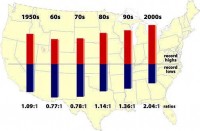
Bruce Hall did an analysis and follow-up. He extended the time period back to the start of the century and found the 1930 had a much higher frequency of maximum temperature extremes than the 1990s or 2000s or the combination of the last two decades (below, enlarged here).
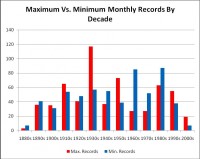
Dr. Richard Keen of the University of Colorado provided evidence from the western parts of the US and Canada supporting Bruce’s findings (below, enlarged here).
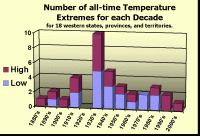
There were links also to WUWT, World Climate Report studies as well. Here below, Dr. Keen follows up his analysis expanding to all of the US and Canadian provinces and territories and shows there is no warming trend the last century.
Thanks for posting my chart of Western US and Canadian extreme temperature records by decade. I’m sure that by now the usual suspects have accused us of picking all of their cherries by showing only the western half of North America. Therefore, I spent the evening creating more charts for all 50 US states and 12 Canadian provinces and territories (excluding Nunavut, which was part of the Northwest Territories until recently).
I’m sending charts for the US, for Canada, and for the two combined. They tell the same story that my earlier Western North American graph showed, but more dramatically! MORE THAN HALF of the state and provincial maximum temperature records were set during the single decade of the 1930’s, and only 29 percent of these records were set since 1950. This means that by considering temperatures after 1950, Meehl et al. removed most of the really good heat records from the data pool, and artificially inflated the number of maximum temperature records (and thus, the max to min ratio). In other words, many of the maximum temperature records since 1950 would not be daily records for the entire period of record for these stations.
Meehl et al. calculate the max-to-min record ratio for each decade, but the difference (max MINUS min) is more illustrative (and not influenced by choice of denominator). That chart clearly shows the dominance of maximum temperature records during the 1930’s, and that since then most decades have had more minimum records set, and since 1940 minimum records have outnumbered maximum records by a ratio of 3 to 2 (or 1.5 to 1, if you prefer). Meehl et al. achieved opposite ratios by removing the extremes of the 1930’s.
No doubt the cherry pickers will note that although most of North American is included in this analysis (and not just the US), I deftly left out the Yamal Peninsula, which, as we all know, is the true key to global climate. So I’ve created one more graph - a tally of the records for the seven continents, including Asia, which includes Siberia, where the Yamal Peninsula resides. What’s it show? Since 1950, 3 maximum and 4 minimum records have been set for the continents, a fairly even break.
Finally, although I consider linear trend lines somewhat useless and occasionally deceptive, I plotted those for each graph. In all cases, the trend line is virtually indistinguishable from the zero-value axis, so it is not shown. The bottom line is that if one wishes to express climate change by the varying number of temperature extremes, there has been no climate change for over 100 years.
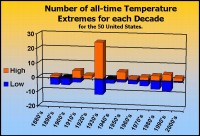
See larger here.
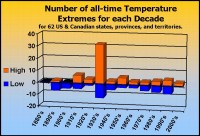
See larger here.
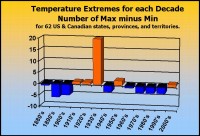
See larger here.
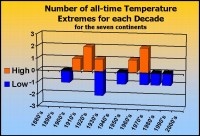
See larger here.
|










